The History of New Mexico
Collapse
Expand
-
Chapter 2: New Mexico's First Peoples
- New Mexico's First Peoples
- Recovering First Peoples' Humanity
- Ancient Culture Regions
- Development of Pueblo Society
- Athabaskan Peoples
- Eve of the Spanish Invasion
- References & Further Reading
As Jemez Pueblo historian Joe S. Sando has pointed out, anthropologists and historians have traced the historical geography of Pueblo peoples through their ceramics and artifacts, whereas the Pueblos themselves rely on “songs of various societies in tracing the places where their ancestors may have been.”2 As other native scholars suggest, these two types of knowledge are not diametrically opposed nor mutually exclusive. Pueblo histories complement those of scholars, although the terms used by each tend to be different.
According to archaeological evidence, the Archaic Period (about 9,500 BCE to 500 BCE) was a time of creativity and adaptation to major changes in the region’s climate. During this period people continued to live as hunters and gatherers, but they hunted smaller game such as elk, deer, or rabbits. This adaptation required the use of smaller arrowheads and different types of tools. Plants were a more important part of subsistence as well. Holocene peoples gathered wild grains that were ground into flour with stone tools. Additionally, various groups of people became more locally rooted. The ranges over which they seasonally gathered plants and hunted were smaller. This change was a crucial step in the development of a sense of homeland and community, and the people recognized their place in a living world that sustained their families. In the case of the Archaic Period, archaeological evidence pinpoints dates and types of tools used. Patterns of migration, hunting and gathering are corroborated with different meaning in Pueblo oral traditions.
As early New Mexicans worked to make their lives from the land, subtle processes marked their gradual adaptation of more sedentary lifestyles based on agricultural production. By the first decades CE, three distinct cultural traditions coalesced in different parts of the region. The Mogollon cultural zone covered present-day southwestern New Mexico, southeastern Arizona, and northwestern Chihuahua. It was the southernmost of the three, and had the closest contact with the peoples of north-central Mexico. The Hohokam area centered on present-day Arizona and Sonora, and the Ancestral Puebloan culture was located in the four-corners region. As the people in each of these areas became more dependent on agricultural production for their livelihoods, they also built permanent dwellings and other structures that were used for religious observances. Their architectural remains present evidence about their geographic dispersion, as well as their cultural practices. The Hohokam were the ancestors of the Tohono O’odham peoples of the present-day Arizona-Sonora border area. The Mogollon and Ancestral Puebloan cultures were the forerunners of the various Pueblo peoples that inhabited the Rio Grande corridor by 1250-1300 CE.
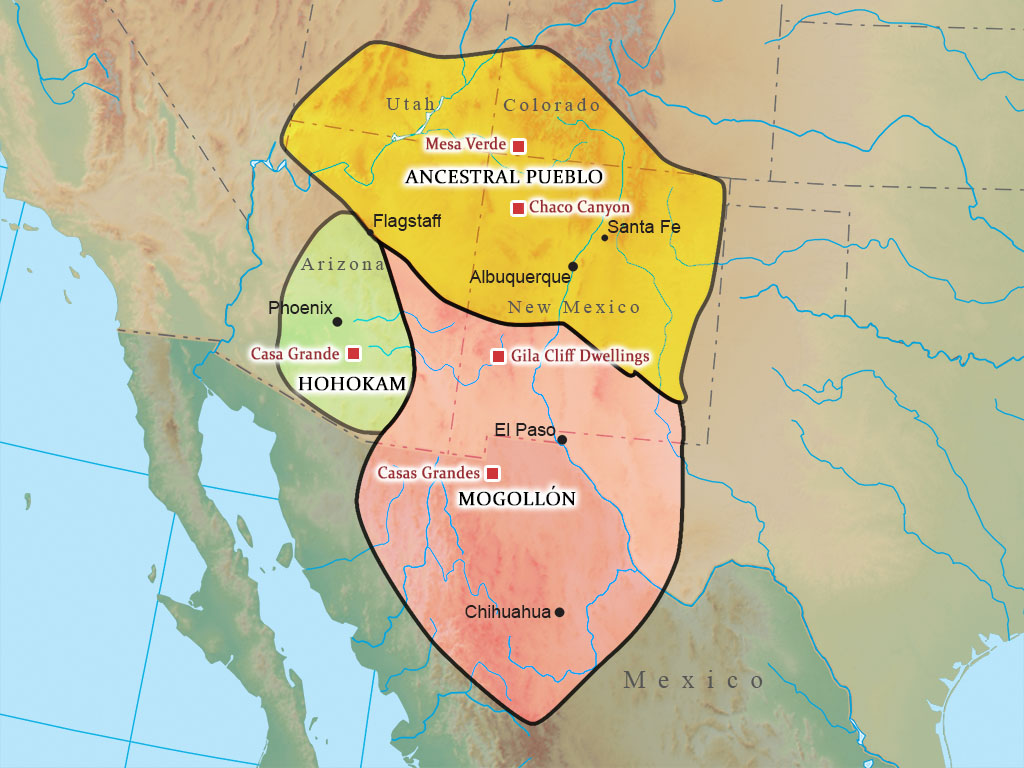
These three different cultures reached their zenith at different points in time. Scholars highlight these particular ancient peoples because they all adopted sedentary agricultural lifestyles. Yet, other, smaller groups of people that did not depart from their nomadic lifeways inhabited in the region as well. Because the world’s major literate civilizations and societies were built on the adaptation of sedentary living, most attention has traditionally been given to ancient societies that adopted such modes of life. As in our discussion of indigenous peoples’ modes of thinking about their own history, it is also important for us to understand nomadic lifeways on their own terms. The factors that led early societies, whether in New Mexico or the Fertile Crescent, to adopt agriculture are varied and quite complex. The domestication of plants and animals was a long process filled with trial and error. For some peoples, the costs of such changes, as well as close adherence to their own worldviews, translated into a rejection of sedentary agriculture. Athabaskan peoples, the ancestors of Navajo and Apache groups that continue to inhabit New Mexico, are prime examples. Later, the Comanche people were also able to construct a powerful, nomadic empire on the plains of eastern New Mexico, west Texas, and the mountainous regions of northern Mexico.
It may not make sense to speak of a Neolithic “Revolution” as archaeologists and historians did in the past. In the context of world history, the Neolithic (or “New Stone Age”) Revolution marked the transition to sedentary agriculture. In the Middle East, the Neolithic era spanned the period between about 10,000 BCE and 4,000 BCE. Despite the title “revolution,” the transition to plant and animal domestication and sedentary lifestyles was a long, drawn-out process. Revolutions, on the other hand, tend to be shorter periods of rapid change. Even for societies that adopted sedentary life, the changes that comprised that shift took place over hundreds of years. Perhaps we could say that the period was a revolution in that it ushered in significant and lasting transformations for many human societies, but it is important to recognize the long-term nature of such adaptations.

From the work of Fray Bernadino de Sahagún – Courtesy of Bilingual Press
In central Mexico, the cultivation of maize, beans, and squash began sometime around 8,000 BCE. Squash was the earliest domesticated crop; corn and beans followed between 7,500 and 4,000 BCE. Tellingly, hunting and gathering lifeways continued for millennia in Mesoamerica (the larger region that encompasses present-day Mexico and Central America). It was only in the second millennium BCE that village life appeared, due to the innovation of farming. Food surpluses allowed for larger groups of people to live in close proximity to one another and build social and cultural ties. During the formative period in Mesoamerica (beginning in about 1,000 BCE) Olmec peoples built cultural traditions that influenced societies along the gulf coast and Valley of Mexico until the arrival of Spaniards in the early 1500s.
As early as 2,500 BCE, farming techniques began to spread to the north and south throughout Mesoamerica. Around 1,500 BCE Mogollon peoples were the first in the New Mexico region to domesticate corn, beans, and squash due to their proximity to other groups that lived to their south in present-day Mexico. As was the case for their southern neighbors, Mogollon peoples did not adopt full-fledged agriculture or sedentary lifeways until over two millennia later. Not until about 600 CE did they inhabit villages on a year-round basis. Once they made the transition, they constructed pit homes that consisted of timber and dirt walls and roofs built on top of two-to-four foot deep round holes. Clusters of pit houses made up their villages, which were typically located atop mesas. The development of ceramic pottery that replaced their earlier baskets was another hallmark of this period of transition.
Mogollon peoples relied on irrigation to a lesser extent than the Hohokam or Ancestral Puebloans. They were also relatively isolated from outside intrusion due to the terrain of the Mogollon-Datil region that was (and is) comprised of volcanic mountains and mesas. Over time, their homes and villages became more complex. By the Mimbres Classic period, 950-1130 CE, they inhabited above ground, joined housing structures much like the later Pueblo peoples. Their villages also included a kiva structure used for ceremonial purposes. Their dead were buried in shallow pit-graves that were at times enclosed in adobe structures. At other times, their burial mounds were located outside of the villages near refuse heaps.
The SU, or “Shoe,” site near the northern extent of the Mogollon culture region (west-central New Mexico) was composed of forty houses. Its inhabitants, and those of the surrounding area, were the ancestors of the later Zuni, Acoma, and Hopi peoples. Archaeologists have also spent much time studying the Mogollon along the Mimbres River near the present-day New Mexico-Chihuahua border. The largest Mogollon group was the Casas Grandes subset in present-day northwestern Chihuahua. From each of these groups, archaeologists have learned much about Mogollon cultures. Pottery, homes, and burial sites tell us much about how their people lived.
These types of evidence also allow researchers to form hypotheses about the types of social structures that existed throughout the Mogollon region. By tracing distinctive styles of pottery, archaeologists can pinpoint the extent of different culture areas as well as trade networks. For example, Mimbres black-on-white pottery featured distinctive geometric and figural designs that evolved over time. Additionally, the existence of prestige goods at burial sites allows archaeologists to trace trade items that came into each different village from outside the region. At the SU and Casas Grandes sites, for example, macaws, cages, and sea shells, among other items not native to the area, appear in burial mounds. These items not only suggest trade with peoples in coastal areas and further to the south, they also suggest hierarchical class structure. Most archaeologists support the theory that Mogollon and Ancestral Puebloan societies were built on social structures that were dominated by religious and economic elites.
Although past researchers referred to the northernmost of the three cultures as the Anasazi, the current trend is to refer to this group as Ancestral Puebloan. The term Anasazi was borrowed from the Navajo language. It may either mean “old ones,” or “enemies of our ancestors.” Due to its negative connotation and the idea that the term originated outside of Ancestral Puebloan languages themselves, the term Anasazi has generally fallen out of usage. Most Pueblo peoples object to the use of Anasazi, although there is not a general consensus about which term to use instead. Most have come to accept the more generic Ancestral Puebloan label, although a few, such as the Hopi, continue to use their own individual terms for their progenitors. English professor, rock climber, and author David Roberts, however, justifies his continued usage of Anasazi by explaining that the term “Puebloan” originated from Spanish colonizers that were far more oppressive to the region’s inhabitants than the Navajos. Because Pueblo peoples themselves object to the use of Anasazi, I use Ancestral Puebloan despite any connections it may have to the legacies of colonialism.
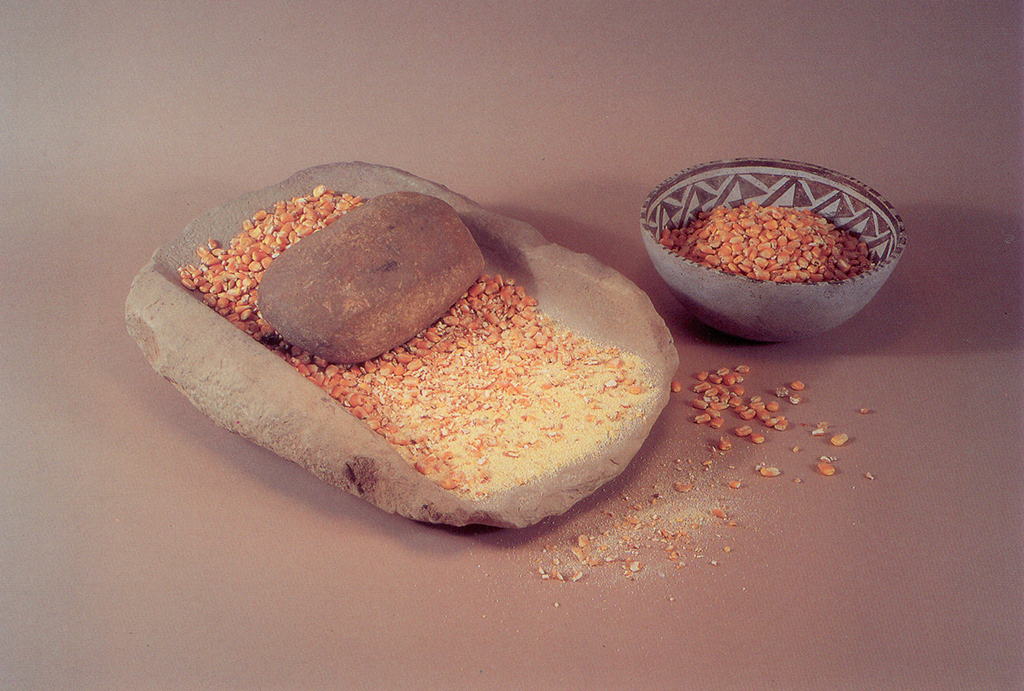
Courtesy of [glossary_exclude]Mesa Verde[/glossary_exclude] Museum Association
Ancestral Puebloan peoples were the last of the three ancient cultural groups to create unique traditions that set them apart from others and identified them as a group. Because they lived in the same general location for over 1,500 years, archaeologists have been able to learn quite a lot about them. In the first few centuries CE, they began the cultivation of corn, beans, and squash and they constructed villages of pit houses. As they adopted these new technologies and modes of living, their tool kits changed accordingly. To mill their corn, they used a flat stone called a metate and a grinding tool known as a mano. From the corn meal, they made corn cakes—the staple of their diet. As with Hohokam and Mogollon peoples from whom they certainly borrowed, their pottery developed over time and was used in the cooking and storage of food.
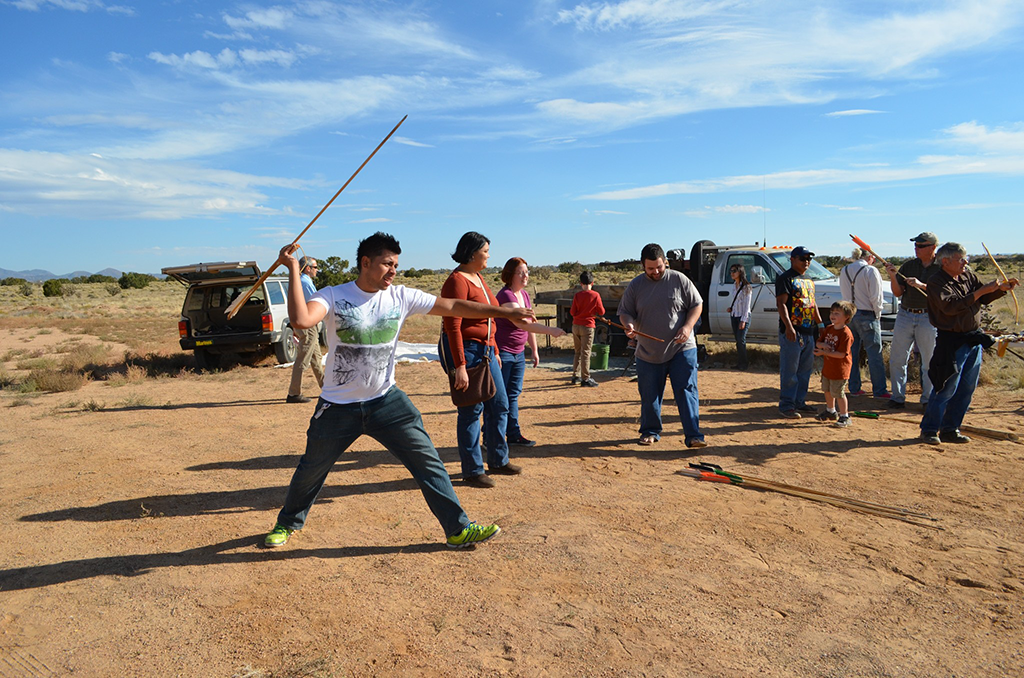
Courtesy of Melanie E Magdalena, Origins Scientific Research Society
Like other early societies, the Ancestral Puebloans’ transition to fully sedentary lifeways was a long process. Researchers have divided their history into two general periods: Basketmaker and Pueblo eras. The Basketmaker period lasted from the earliest years CE through about 700 when most Ancestral Puebloan peoples began to permanently reside in the same place year round. During the Basketmaker period, the people were nomads who practiced hunting and gathering for their subsistence. They used a weapon called an atlatl (a Nahua term), which was a device that hurled spears. Toward the end of the era, they also began to use bows and arrows which they likely adopted through contact with people that lived to the north.
Between 700 and 1050, known as the Developmental Pueblo period, they built rows of houses above ground in U or L shaped configurations. At the center of each village was the kiva, a pit house constructed for religious purposes. Most kivas were round, although some were square in shape. A ladder extended through an opening in the mud-covered roof to provide access to the ceremonial chamber. Over time, kivas became increasingly more important to Ancestral Puebloan peoples, and their use was continued by their Pueblo descendants. Based on oral traditions, as well as more recent usage patterns by Pueblos, archaeologists believe that kivas and ritual artifacts were the domain of men. Although women were excluded from kiva worship, they dominated home life and extended family relations. They constructed their houses and furnishings, and, in many cases, women oversaw planting and harvesting. Theirs was a matrilineal culture in which inheritance passed from mother to daughter. Familial bonds were also traced through female bloodlines.
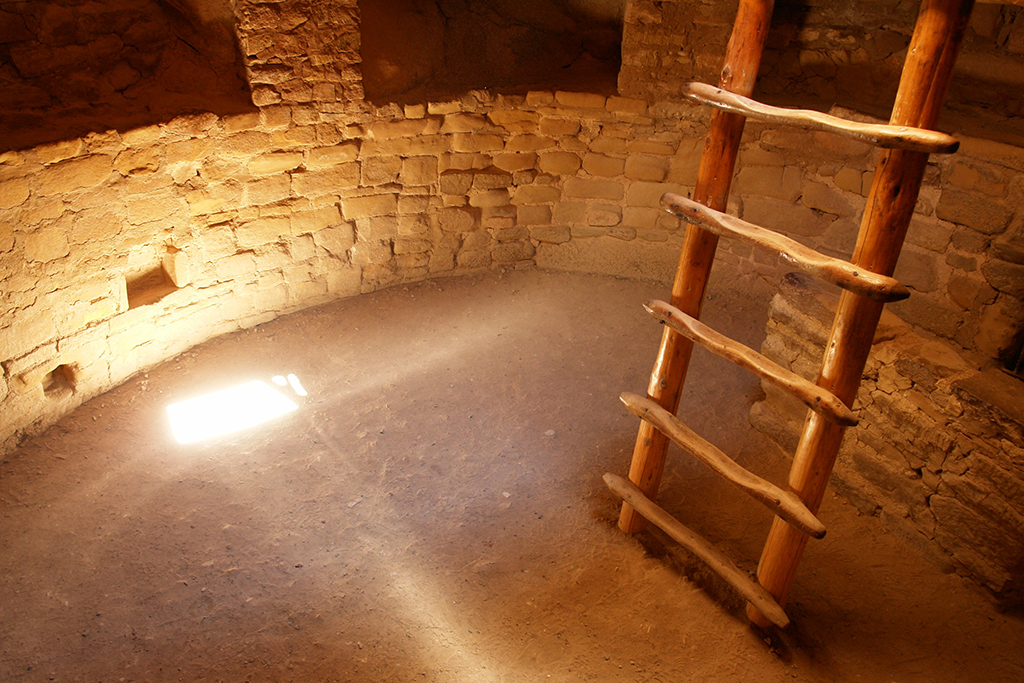
Courtesy of Alex E. Proimos
The Great Pueblo period lasted from about 1050 to 1250, and it was a time of advancement in the types of masonry techniques that Ancestral Puebloans employed to construct homes and other structures. It was also a period of territorial expansion toward the south and southeast as Ancestral Puebloan culture reached its apex.
Chaco Canyon was the site of the most extensive apartment-house dwellings that were constructed during this time frame. Work on Pueblo Bonito began around 900, although final additions were not completed until 1130. It stood four or five stories tall with over 650 plastered rooms that housed as many as 1200 people. The complex also included dozens of kivas and other ceremonial artifacts. During the period between 1020 and 1120, Chaco Canyon contained sixteen different settlements that housed between 5,000 and 6,000 people. Pueblo Bonito’s great house connected to other housing structures in the canyon by a line of sight that facilitated rapid communication. Various structures were also aligned with the sun and stars and marked the phases of the moon, leading archaeologists to conclude that their inhabitants possessed a complex understanding of the connections between astronomical phenomena, the cycles of the seasons, and the passing of time.
An extensive road network branched out from Chaco Canyon toward other Ancestral Puebloan sites in the region and beyond. Chacoan roads ranged between ten to thirty feet in width and they included stairways where necessary to provide access to the region’s cliffs and mesas. Some of these roads connected to Mesa Verde, located in southwestern Colorado, and Canyon de Chelly, in eastern Arizona, which contained structures that were equal to Pueblo Bonito in grandeur. All of these major sites contained advanced irrigation systems that not only tapped into local, seasonal water flows, but that also collected rainfall. Irrigation agriculture provided Ancestral Puebloan peoples with time to dedicate to religious, cultural, and social observances because it required less of their time than full-time hunting and gathering. Hunting and gathering continued to provide important supplemental nutrition and variety to their diet, however.
Religious observances connected every aspect of day-to-day life. Ancestral Puebloans spent much of their time creating pottery; each group created unique shapes and designs that reflected their efforts to connect to spiritual forces all around them in the landscape and the skies. They also covered the walls of their kivas with ceremonial murals, wove clothing and other textiles, and fashioned turquoise jewelry. Prestige goods, such as parrots and macaws, came to the region by way of trade networks that extended to central Mexico. Spiritual concerns defined the social order. Medicine men, or shamans, played a vital role as intermediaries with supernatural powers that provided rain, fertility, protection from enemies, and other life-giving elements to the people. Due to their social importance, medicine men held great respect and authority. They controlled food and resource surpluses that proved crucial to the continuation of Chacoan culture during times of drought and famine. They also developed a ritual calendar that marked the movements of the sun, moon, and stars. Archaeological and traditional evidence suggests that the Ancestral Puebloan society was highly stratified, with religious figures and war chiefs holding authority over others.
A central question for both the Ancestral Puebloan and Mogollon culture regions is how and why they were abandoned. Both seem to have entered a period of decline by the 1100s, but scholars posit different reasons for their abandonment. For Mogollon peoples, migration from Hohokam areas and neighboring nomadic groups began to redirect cultural practices by about 800. Drought and other climatic changes also placed pressure on Mogollon peoples’ abilities to provide enough food and water for all. Although researchers formerly argued that migration negatively impacted Mogollon culture, effectively bringing it to an end by introducing new practices and rituals, more recent studies suggest that outsiders may have brought new strategies that aided Mogollon peoples as they themselves migrated to new areas in order to adapt and survive.
Sometime around 1250 Ancestral Puebloan sites at Chaco Canyon, Mesa Verde, and Canyon de Chelly were abandoned. Scholars have marveled at evidence suggesting that the abandonment occurred in “a rather orderly fashion at a point of considerable technological development.”3 If such was the case, why would these people walk away from their homes? Archaeologists initially thought that Athabaskan invaders from the north had forced the flight. Although conflict and raids may have been a contributing factor, most scholars support the theory that sustained climate change forced Ancestral Puebloans to leave. Additionally, scholars continue to debate the time of Athabaskan arrival in the region. Some argue that they did not enter the Southwest until just prior to the arrival of the Coronado expedition in 1540.
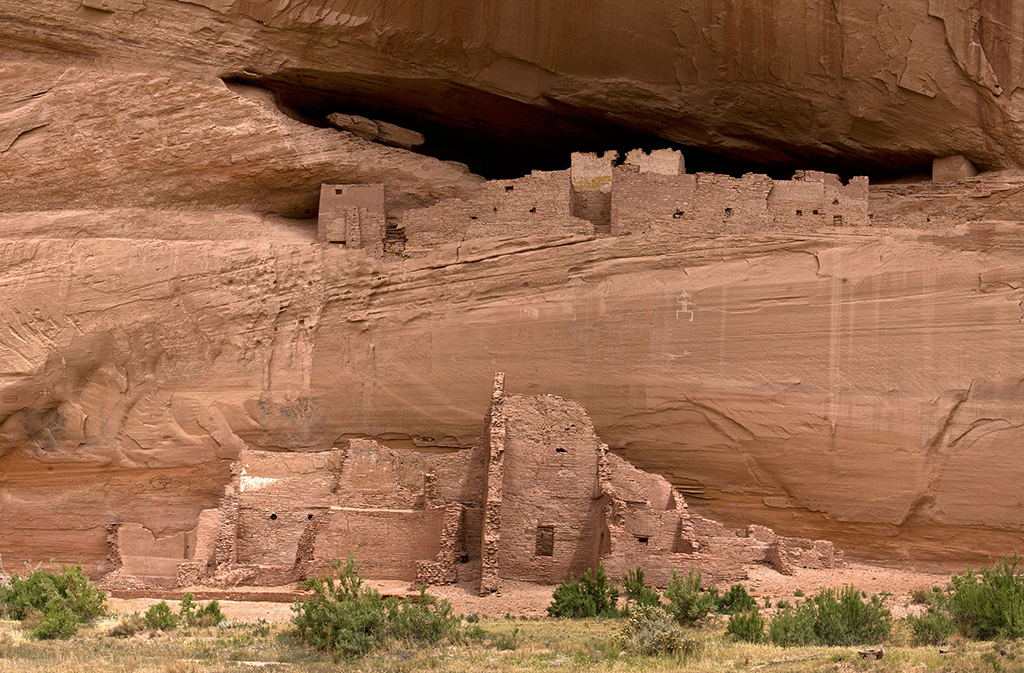
Courtesy of Cacophony
A cycle of droughts plagued the four-corners region between 1100 and 1300. The first drought arrived around 1090, causing crops in the fields to dry up. Rain rebounded for a short time about a decade later, but a longer drought pattern set in by 1130 or so. Drought patterns continued over the next couple of centuries. In 1276, for example, a sustained twenty-three-year drought began. Certainly such conditions caused conflict and placed stress on people’s ability to support themselves in the dry environment. Internal conflicts and divisions may have also complicated matters.
According to Pueblo oral traditions, the people abandoned their dwellings when the serpent, their deity of rain and fertility, unexpectedly disappeared one evening. Without the serpent, the Ancestral Puebloans felt helpless to survive. In response, they gathered their possessions and followed the trail of the serpent to a riverbank, where they began to build new homes. Other oral histories explain that the long drought of the twelfth century was a result of Mother Earth tearing apart. As a result, they began another series of migrations that eventually led them, in smaller groups, to the locations they inhabited when the Spaniards arrived. For Pueblos, the transition was part of their history told “from the beginning.” Chaco Canyon and other Ancestral Pueblo sites continue to hold sacred significance for most Pueblo peoples today.